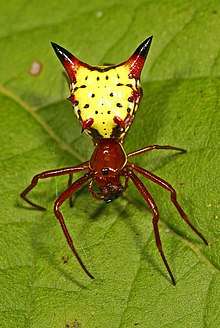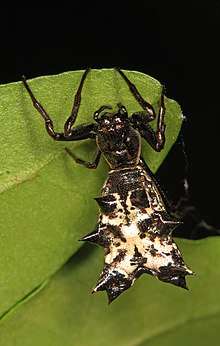Micrathena
Micrathena, known as spiny orbweavers, is a genus of orb-weaver spiders first described by Carl Jakob Sundevall in 1833.[5][6] Micrathena contains more than a hundred species, most of them Neotropical woodland-dwelling species. The name is derived from the Greek "micro", meaning "small", and the goddess Athena.[7]
| Micrathena | |
|---|---|
 | |
| Micrathena sagittata in Virginia, USA | |
| Scientific classification | |
| Kingdom: | Animalia |
| Phylum: | Arthropoda |
| Subphylum: | Chelicerata |
| Class: | Arachnida |
| Order: | Araneae |
| Infraorder: | Araneomorphae |
| Family: | Araneidae |
| Genus: | Micrathena Sundevall, 1833[1] |
| Type species | |
| Micrathena aureola (C. L. Koch, 1836) | |
| Species | |
|
119, see text | |
| Synonyms[1] | |
Species with extremely long spines evolved at least eight times in the genus Micrathena and likely function as anti-predator defenses.[8] Gasteracantha orb-weavers also have hardened abdomens with variously shaped spines, but they are not closely related to Micrathena within the orb-weaver family.[9]
These spiders are active during the daytime and build vertical orb webs. Unlike many other orb-weavers, members of Micrathena bite their prey before wrapping it. When laying eggs, females will place the egg sac on vegetation near the web.[5]
Species
As of April 2019 the genus Micrathena contains 119 species:[1]

%2C_Panama_(9733219590).jpg)
.jpg)

- M. abrahami (Mello-Leitão, 1948) – Colombia to Brazil
- M. acuta (Walckenaer, 1841) – Trinidad to Argentina
- M. agriliformis (Taczanowski, 1879) – Costa Rica to Bolivia
- M. alvarengai Levi, 1985 – Brazil
- M. anchicaya Levi, 1985 – Colombia, Ecuador
- M. annulata Reimoser, 1917 – Colombia, Brazil, Paraguay, Argentina
- M. armigera (C. L. Koch, 1837) – Brazil, Peru, Guyana
- M. atuncela Levi, 1985 – Colombia
- M. aureola (C. L. Koch, 1836) – Colombia to Suriname, Paraguay
- M. balzapamba Levi, 1985 – Ecuador
- M. bananal Levi, 1985 – Brazil
- M. bandeirante (Magalhaes & Santos, 2011) – Brazil, Argentina
- M. banksi Levi, 1985 – Cuba
- M. beta Caporiacco, 1947 – Guyana, French Guiana, Brazil, Ecuador, Peru
- M. bicolor (Keyserling, 1864) – Colombia, Peru
- M. bifida (Taczanowski, 1879) – Peru
- M. bimucronata (O. Pickard-Cambridge, 1899) – Mexico to Panama
- M. bogota Levi, 1985 – Colombia
- M. brevipes (O. Pickard-Cambridge, 1890) – Mexico to Panama
- M. brevispina (Keyserling, 1864) – Panama to Argentina
- M. carimagua (Levi, 1985) – Colombia, Venezuela
- M. clypeata (Walckenaer, 1805) – Panama to Peru
- M. coca Levi, 1985 – Colombia to Brazil
- M. cornuta (Taczanowski, 1873) – Colombia to Brazil
- M. coroico Levi, 1985 – Bolivia
- M. crassa (Keyserling, 1864) – Costa Rica to Argentina
- M. crassispina (C. L. Koch, 1836) – Brazil, Bolivia, Paraguay, Argentina
- M. cubana (Banks, 1909) – Cuba
- M. cucharas (Levi, 1985) – Peru
- M. cyanospina (Lucas, 1835) – Colombia to Brazil
- M. decorata Chickering, 1960 – Colombia
- M. digitata (C. L. Koch, 1839) – Brazil
- M. donaldi Chickering, 1961 – Costa Rica to Colombia
- M. duodecimspinosa (O. Pickard-Cambridge, 1890) – Guatemala to Colombia
- M. elongata (Keyserling, 1864) – Colombia
- M. embira Levi, 1985 – Colombia, Brazil
- M. evansi Chickering, 1960 – Panama, Trinidad to Brazil
- M. excavata (C. L. Koch, 1836) – Panama to Brazil
- M. exlinae Levi, 1985 – Peru, Brazil
- M. fidelis (Banks, 1909) – Costa Rica to Argentina
- M. fissispina (C. L. Koch, 1836) – Brazil, French Guiana
- M. flaveola (Perty, 1839) – Costa Rica to Argentina
- M. forcipata (Thorell, 1859) – Mexico, Cuba, Hispaniola
- Micrathena f. argentata Franganillo, 1930 – Cuba
- M. funebris (Marx, 1898) – USA to Costa Rica
- M. furcata (Hahn, 1822) – Brazil, Argentina, Uruguay
- M. furcula (O. Pickard-Cambridge, 1890) – Guatemala to Brazil
- M. furva (Keyserling, 1892) – Brazil, Uruguay, Argentina
- M. gaujoni Simon, 1897 – Ecuador, Colombia
- M. glyptogonoides Levi, 1985 – Mexico
- M. gracilis (Walckenaer, 1805) – North, Central America
- M. guayas Levi, 1985 – Ecuador
- M. guerini (Keyserling, 1864) – Colombia
- M. gurupi Levi, 1985 – Brazil, Suriname
- M. hamifera Simon, 1897 – Ecuador to Brazil
- M. horrida (Taczanowski, 1873) – Greater Antilles, Mexico to Argentina
- Micrathena h. tuberculata Franganillo, 1930 – Cuba
- M. huanuco Levi, 1985 – Colombia, Peru
- M. jundiai Levi, 1985 – Brazil
- M. kirbyi (Perty, 1833) – Colombia to Brazil
- M. kochalkai Levi, 1985 – Colombia
- M. lata Chickering, 1960 – Brazil, Argentina
- M. lenca Levi, 1985 – Mexico
- M. lepidoptera Mello-Leitão, 1941 – Costa Rica to Colombia
- M. lindenbergi Mello-Leitão, 1940 – Brazil
- M. lucasi (Keyserling, 1864) – Mexico to Brazil
- M. macfarlanei Chickering, 1961 – Panama to Brazil
- M. margerita Levi, 1985 – Mexico
- M. marta Levi, 1985 – Colombia
- M. miles Simon, 1895 – Brazil, Guyana, Peru
- M. militaris (Fabricius, 1775) – Greater Antilles
- M. mitrata (Hentz, 1850) – USA to Brazil
- M. molesta Chickering, 1961 – Nicaragua to Panama
- M. necopinata Chickering, 1960 – Colombia, Peru, Brazil
- M. nigrichelis Strand, 1908 – Brazil, Paraguay, Uruguay, Argentina
- M. osa (Levi, 1985) – Costa Rica
- M. parallela (O. Pickard-Cambridge, 1890) – Costa Rica, Panama
- M. patruelis (C. L. Koch, 1839) – Brazil, Paraguay, Argentina
- M. peregrinatorum (Holmberg, 1883) – Brazil, Argentina
- M. perfida Magalhaes, Martins, Nogueira & Santos, 2017 – Brazil
- M. petrunkevitchi Levi, 1985 – Mexico
- M. pichincha Levi, 1985 – Ecuador
- M. picta (C. L. Koch, 1836) – Guyana to Paraguay
- M. pilaton Levi, 1985 – Ecuador
- M. plana (C. L. Koch, 1836) – Virgin Is. to Argentina
- M. pungens (Walckenaer, 1841) – Colombia to Bolivia
- M. pupa Simon, 1897 – Colombia, Ecuador
- M. quadriserrata F. O. Pickard-Cambridge, 1904 – Mexico to Venezuela
- M. raimondi (Taczanowski, 1879) – Peru, Ecuador
- M. reali Levi, 1985 – Brazil
- M. reimoseri Mello-Leitão, 1935 – Brazil
- M. rubicundula (Keyserling, 1864) – Colombia, Ecuador
- M. rufopunctata (Butler, 1873) – Jamaica
- M. ruschii (Mello-Leitão, 1945) – Brazil
- M. saccata (C. L. Koch, 1836) – Honduras to Brazil
- M. sagittata (Walckenaer, 1841) – North, Central America
- M. sanctispiritus Brignoli, 1983 – Brazil, Argentina
- M. schenkeli Mello-Leitão, 1939 – Trinidad to Paraguay
- M. schreibersi (Perty, 1833) – Nicaragua to Brazil
- M. sexspinosa (Hahn, 1822) – Mexico to Brazil
- M. shealsi Chickering, 1960 – Argentina
- M. similis Bryant, 1945 – Hispaniola
- M. soaresi Levi, 1985 – Brazil
- M. spinosa (Linnaeus, 1758) – Suriname, French Guyana, Brazil
- M. spinulata F. O. Pickard-Cambridge, 1904 – Mexico
- M. spitzi Mello-Leitão, 1932 – Brazil, Argentina
- M. striata F. O. Pickard-Cambridge, 1904 – Mexico, Guatemala
- M. stuebeli (Karsch, 1887) – Colombia, Ecuador
- M. swainsoni (Perty, 1833) – Brazil, Paraguay, Argentina
- M. teresopolis Levi, 1985 – Brazil
- M. triangularis (C. L. Koch, 1836) – Trinidad to Brazil
- M. triangularispinosa (De Geer, 1778) – Trinidad to Bolivia
- M. triserrata F. O. Pickard-Cambridge, 1904 – Mexico to Belize
- M. tziscao Levi, 1985 – Mexico
- M. ucayali Levi, 1985 – Peru, Brazil
- M. vigorsi (Perty, 1833) – Colombia to Brazil
- M. woytkowskii (Levi, 1985) – Colombia, Peru
- M. yanomami Magalhaes & Santos, 2011 – French Guiana, Brazil, Peru
- M. zilchi Kraus, 1955 – Mexico to El Salvador
In North America
Although the genus includes over a hundred species, only four are found in the United States and Canada.[10] Among those four species, female spined micrathena (Micrathena gracilis) have five pairs of conical tubercles, female M. mitrata have two short posterior pairs, and female arrow-shaped micrathena (M. sagittata) have three pairs.[5] The only species recorded from Canada is M. sagittata, found in Ontario.[5]
References
- "Gen. Micrathena Sundevall, 1833". World Spider Catalog. Natural History Museum Bern. Retrieved 2019-05-14.
- Magalhaes, I. L. F.; Santos, A. J. (2012). "Phylogenetic analysis of Micrathena and Chaetacis spiders (Araneae: Araneidae) reveals multiple origins of extreme sexual size dimorphism and long abdominal spines". Zoological Journal of the Linnean Society. 166: 29.
- Levi, H. W. (1985). "The spiny orb-weaver genera Micrathena and Chaetacis (Araneae: Araneidae)". Bulletin of the Museum of Comparative Zoology. 150: 440.
- Scharff, N. (1991). "On the synonymy of Thaumastobella mourei Mello-Leitão and Ildibaha albomaculata Keyserling (Araneae, Araneidae)". Journal of Arachnology. 19: 155.
- "Genus Micrathena". BugGuide. Retrieved 2019-05-14.
- Sundevall, C. J. (1833). Conspectus Arachnidum.
- Ubick, D.; Paquin, P.; Cushing, P.E.; Roth, V., eds. (2005). Spiders of North America: An Identification Manual. American Arachnological Society.
- Magalhaes, Ivan L F; Santos, Adalberto J. (September 2012). "Phylogenetic analysis of Micrathena and Chaetacis spiders (Araneae: Araneidae) reveals multiple origins of extreme sexual size dimorphism and long abdominal spines". Zoological Journal of the Linnean Society. 166 (1). doi:10.1111/j.1096-3642.2012.00831.x. Retrieved 2016-09-07.
- Scharff, Nikolaj; Coddington, Jonathan A.; Blackledge, Todd A.; Agnarsson, Ingi; Framenau, Volker W.; Szűts, Tamás; Hayashi, Cheryl Y.; Dimitrov, Dimitar (23 April 2019). "Phylogeny of the orb‐weaving spider family Araneidae (Araneae: Araneoidea)". Cladistics. doi:10.1111/cla.12382. hdl:1956/22200.
- Hentz, N. M. (1850). "Descriptions and figures of the araneides of the United States". Boston J. nat. Hist. 6: 18–35, 271–295.